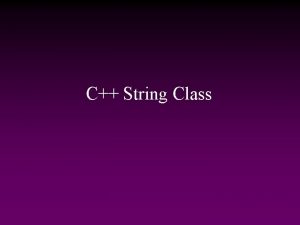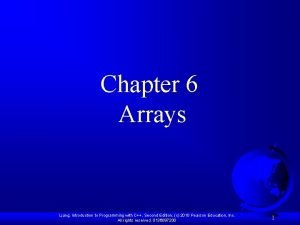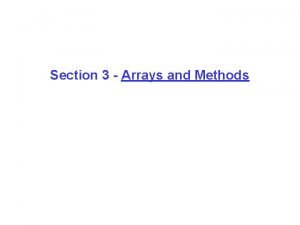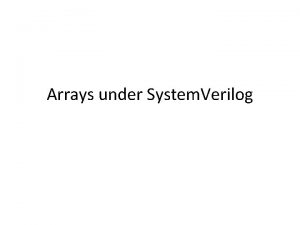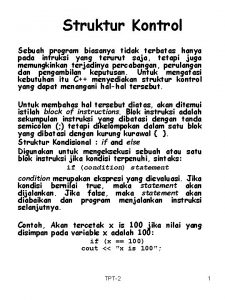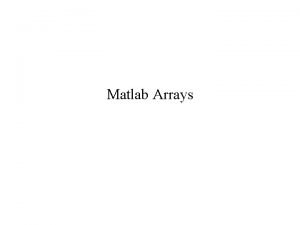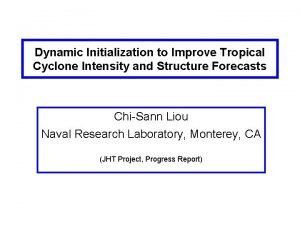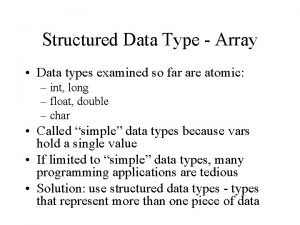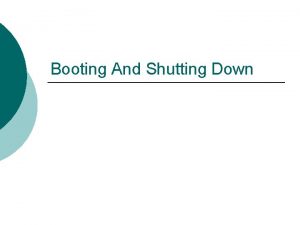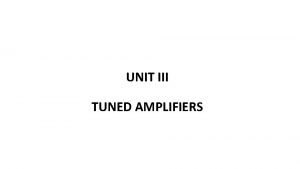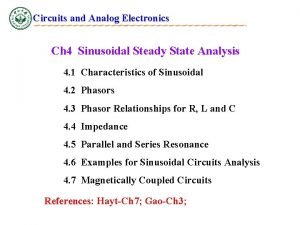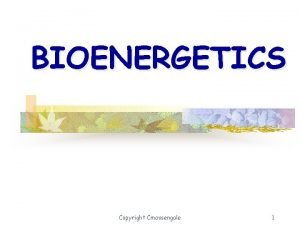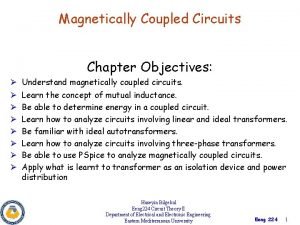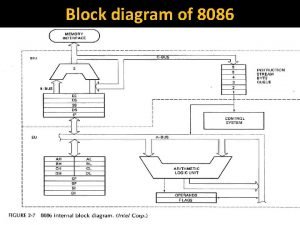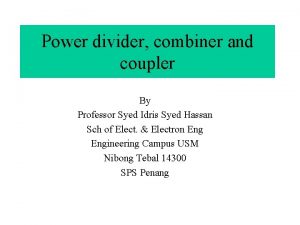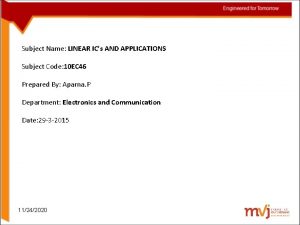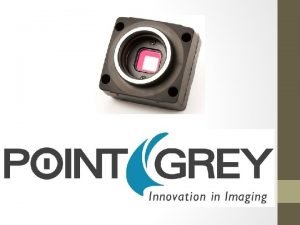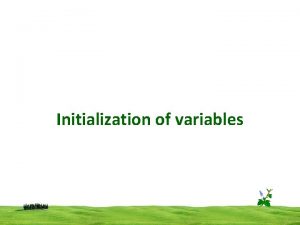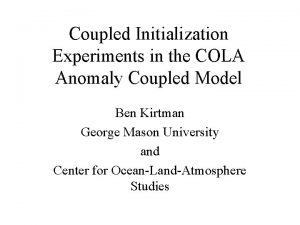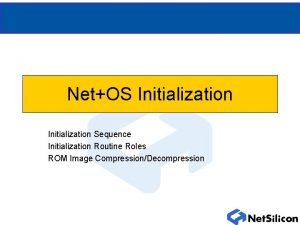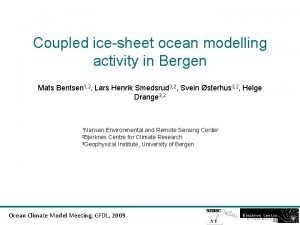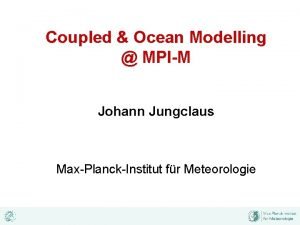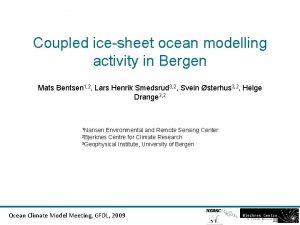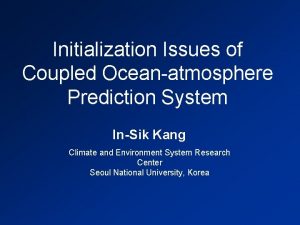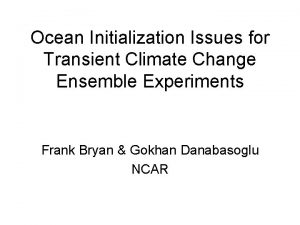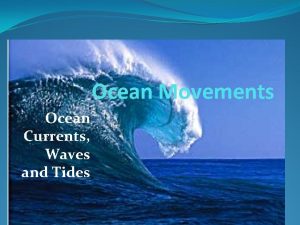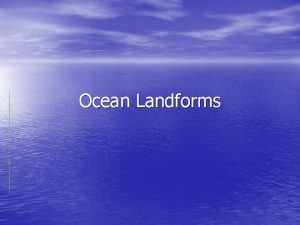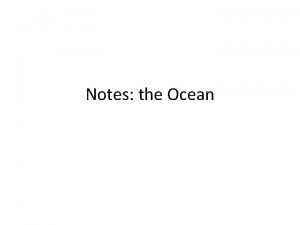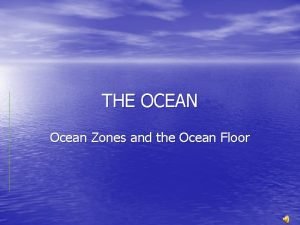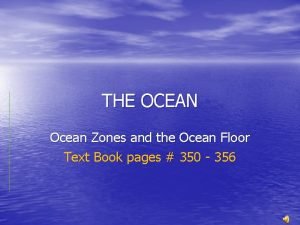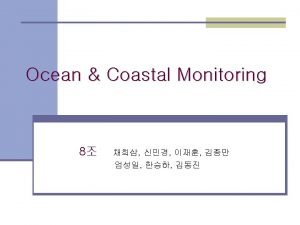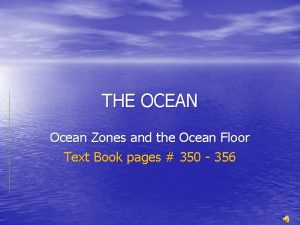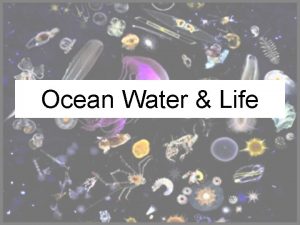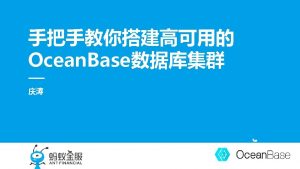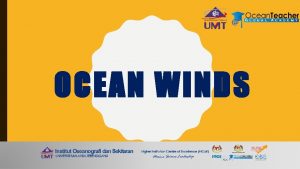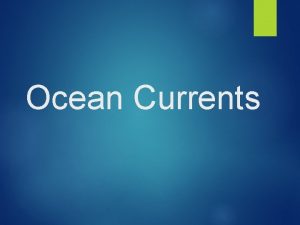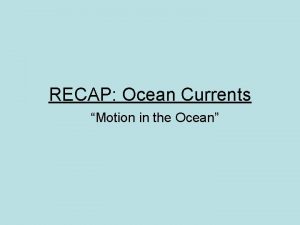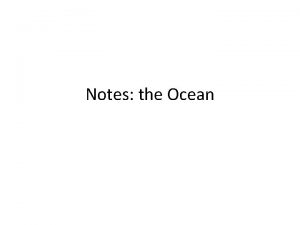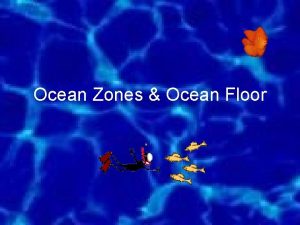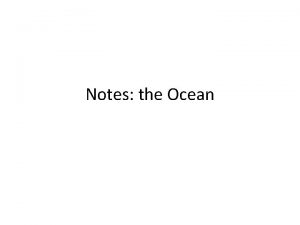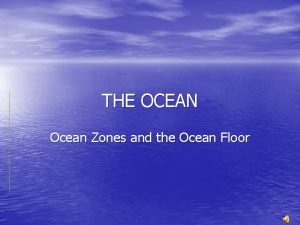Improved Ocean Initialization for Coupled Modelling for week2







![Model: Monthly variability of the SST [1996: 2007] min during DJF in upper Bo. Model: Monthly variability of the SST [1996: 2007] min during DJF in upper Bo.](https://slidetodoc.com/presentation_image_h/7469aa9bbb0c283704a98c65f79d702a/image-8.jpg)
![ORAS 4: Monthly variability of the SST [1996: 2007] • • Model is able ORAS 4: Monthly variability of the SST [1996: 2007] • • Model is able](https://slidetodoc.com/presentation_image_h/7469aa9bbb0c283704a98c65f79d702a/image-9.jpg)
![Model: Monthly variability of the SSS [1996: 2007] Model: Monthly variability of the SSS [1996: 2007]](https://slidetodoc.com/presentation_image_h/7469aa9bbb0c283704a98c65f79d702a/image-10.jpg)
![ORAS 4: Monthly variability of the SSS [1996: 2007] • model underestimates the SSS: ORAS 4: Monthly variability of the SSS [1996: 2007] • model underestimates the SSS:](https://slidetodoc.com/presentation_image_h/7469aa9bbb0c283704a98c65f79d702a/image-11.jpg)
![Model: Monthly variability of the SSH [1996: 2007] Arabian sea SSH is very small Model: Monthly variability of the SSH [1996: 2007] Arabian sea SSH is very small](https://slidetodoc.com/presentation_image_h/7469aa9bbb0c283704a98c65f79d702a/image-12.jpg)
![ORAS 4: Monthly variability of the SSH [1996: 2007] • • Model SSH is ORAS 4: Monthly variability of the SSH [1996: 2007] • • Model SSH is](https://slidetodoc.com/presentation_image_h/7469aa9bbb0c283704a98c65f79d702a/image-13.jpg)
![Model: Monthly variability of the MLD [1996: 2007] Ø lowest in the months of Model: Monthly variability of the MLD [1996: 2007] Ø lowest in the months of](https://slidetodoc.com/presentation_image_h/7469aa9bbb0c283704a98c65f79d702a/image-14.jpg)
![ORAS 4: Monthly variability of the MLD [1996: 2007] ORAS 4: Monthly variability of the MLD [1996: 2007]](https://slidetodoc.com/presentation_image_h/7469aa9bbb0c283704a98c65f79d702a/image-15.jpg)











- Slides: 26

Improved Ocean Initialization for Coupled Modelling for week-2 Monsoon forecast SUNEET DWIVEDI K Banerjee Centre of Atmospheric and Ocean Studies, M N Saha Centre of Space Studies University of Allahabad, INDIA

Objectives v Development, Configuration and Execution of Indian Ocean State Estimation system using Ocean component of Unified Model (UM) of Met Office (UK) and its associated Data Assimilation scheme (viz. NEMO and NEMOVAR) v Generation of quality controlled four-dimensional (threedimensional time varying) geophysical state of the Indian Ocean (with emphasis on ocean’s upper hydrographic/thermal structure and flow field) v To provide coherent estimates of space-time varying upper Ocean mixed layer depth

RELEVANCE q To achieve better prediction ability for medium-range monsoon forecast, improved Indian ocean initializations are important. q Observing the physical state of the Indian ocean is however challenging: size, high variability, lack of extant quality observations continuous in space and time. q Research expeditions are conducted to study specific processes at a regional scale, but such data suffers from being too sparse in space and time. q The satellite measurements have superior space/time coverage, but are they restricted to surface variables only, and can be hard to combine with in-situ data. q approach: use a ocean circulation model NEMO and optimally combine it with the available observations using NEMOVAR data assimilation

Outline (First Year Progress Report): v Indian Ocean circulation modeling around AS and Bo. B at 25 km resolution using NEMOAGRIF v Geophysical fields (3 -D time evolving flow field and hydrographic structure) of the region [70 -95 E; 0 -20 N] during 1996 -2007 (12 years) v Upper Ocean mixed layer depth variability

Indian Ocean Modeling Eddy Resolving Forward Model: Hydrostatic NEMO ocean model ORCA-tripolar grid, Boussinesq, incompressible Navier-Stokes equations, thermodynamics equations 1 degree global run; Mesh refinement using AGRIF Nested run with 25 Km horizontal resolution over IO: [70 -95 E, 0 -20 N]; 46 levels in vertical (from 5 m in the upper ocean to 500 m near the floor) 6 -hourly Coordinated Ocean-ice Reference Experiments (CORE)-II air-sea forcings (atemp, rel. hum. , downward LWR, downward SWR, precip, runoff, U wind, V wind) Initial hydrographic state from WOA 09 climatology KPP boundary layer parameterization to represent subgrid scale processes: vertical mixing Harmonic/Laplacian dissipation (viscosity/diffusion) Two years spin-up [1994 -1995]; Twelve years of simulation [1996 -2007]

Methodology Customization and Configuration of the Indian Ocean Modeling system v Ocean general circulation model: (a) NEMO (global at 1 degree) (b) NEMO-AGRIF is configured to run at eddy resolving scales (~25 Km) over the northern Indian Ocean [70 -95 E; 0 -20 N] v AGRIF: v package for the integration of adaptive mesh refinement (AMR) features within a multidimensional model v written in Fortran and discretized on a structured grid v nesting capability allows resolution to be focused over a region of interest by introducing additional grids Global Run provides open boundary for the nested run in real-time: simultaneous integration • v 12 years model run during 1996 -2007 with CORE-II forcings Output: Time-evolving physical fields likely to be consistent with the observations v Hydrography (Temperature and Salinity) and Velocity v Mixed Layer Depth v Transport (Volume/Mass Flux, Heat Flux, Freshwater Flux)

BATHYMETRY OF THE REGION OF INTEREST (ORCA tripolar grid) Shifting of the ORCA grid: 1 degree non-trivial: requires code development AGRIF nesting: 25 km resolution
![Model Monthly variability of the SST 1996 2007 min during DJF in upper Bo Model: Monthly variability of the SST [1996: 2007] min during DJF in upper Bo.](https://slidetodoc.com/presentation_image_h/7469aa9bbb0c283704a98c65f79d702a/image-8.jpg)
Model: Monthly variability of the SST [1996: 2007] min during DJF in upper Bo. B; max during Apr-May
![ORAS 4 Monthly variability of the SST 1996 2007 Model is able ORAS 4: Monthly variability of the SST [1996: 2007] • • Model is able](https://slidetodoc.com/presentation_image_h/7469aa9bbb0c283704a98c65f79d702a/image-9.jpg)
ORAS 4: Monthly variability of the SST [1996: 2007] • • Model is able to reasonably capture the monthly variability of the SST: r (model, ORAS 4) = 0. 96 Max SST bias is in the range of [-0. 3]o. C : higher near coastal regions; bias is nearly zero in most of the grid points SST mean square error between the model and ORAS 4 is 0. 3 o. C; smaller than the std dev (0. 9 o. C) of the SST
![Model Monthly variability of the SSS 1996 2007 Model: Monthly variability of the SSS [1996: 2007]](https://slidetodoc.com/presentation_image_h/7469aa9bbb0c283704a98c65f79d702a/image-10.jpg)
Model: Monthly variability of the SSS [1996: 2007]
![ORAS 4 Monthly variability of the SSS 1996 2007 model underestimates the SSS ORAS 4: Monthly variability of the SSS [1996: 2007] • model underestimates the SSS:](https://slidetodoc.com/presentation_image_h/7469aa9bbb0c283704a98c65f79d702a/image-11.jpg)
ORAS 4: Monthly variability of the SSS [1996: 2007] • model underestimates the SSS: 2 -3 psu • incorrect mixing parametrization !!!!
![Model Monthly variability of the SSH 1996 2007 Arabian sea SSH is very small Model: Monthly variability of the SSH [1996: 2007] Arabian sea SSH is very small](https://slidetodoc.com/presentation_image_h/7469aa9bbb0c283704a98c65f79d702a/image-12.jpg)
Model: Monthly variability of the SSH [1996: 2007] Arabian sea SSH is very small compared to Bo. B throughout the year Bo. B: minimum SSH close to coast is during Aug-Oct; highest during Apr-May SSH becomes as high as 50 -60 cm in upper Bay and even higher near equator
![ORAS 4 Monthly variability of the SSH 1996 2007 Model SSH is ORAS 4: Monthly variability of the SSH [1996: 2007] • • Model SSH is](https://slidetodoc.com/presentation_image_h/7469aa9bbb0c283704a98c65f79d702a/image-13.jpg)
ORAS 4: Monthly variability of the SSH [1996: 2007] • • Model SSH is underestimated in the Bo. B compared to ORAS 4 Bias is small compared to in GODAS, however
![Model Monthly variability of the MLD 1996 2007 Ø lowest in the months of Model: Monthly variability of the MLD [1996: 2007] Ø lowest in the months of](https://slidetodoc.com/presentation_image_h/7469aa9bbb0c283704a98c65f79d702a/image-14.jpg)
Model: Monthly variability of the MLD [1996: 2007] Ø lowest in the months of Mar-Apr-May; dipole like structure (jan and jul, for example) Ø post-monsoon months: intermediate values as a result of increased freshwater flux; increased wind speed and lower shortwave radiation
![ORAS 4 Monthly variability of the MLD 1996 2007 ORAS 4: Monthly variability of the MLD [1996: 2007]](https://slidetodoc.com/presentation_image_h/7469aa9bbb0c283704a98c65f79d702a/image-15.jpg)
ORAS 4: Monthly variability of the MLD [1996: 2007]

Mean State and Bias • Mean SST is well simulated (both in terms of magnitude and spatial variability) • mean SSS is not (mainly in terms of magnitude): large bias [-2 2]: underestimation !! • MLD bias is higher in the upper Bo. B and eastern coast

Spatio-temporal variability of the SST and SSS: standard deviation • Barring a few places, the model is able to distinguish the region of high and low SST and SSS variability • SST variability decreases from north to south of the domain • SST: Northern Bo. B & AS show higher variability; SSS: higher variability in southern AS as compared to northern AS • In the Bo. B region, however, the northern region shows higher SSS variability

circle: ORAS 4; dots: model § SST : highly correlated: 0. 97 in the Bo. B § SST RMSE: 0. 2 o. C in the Bo. B § SST standard deviation: 0. 8 o. C § SST anomaly peaks during May with a smaller peak in Nov § lowest SST anomaly values are observed during Dec-Jan § Similar results for the SSS § Lowest MLD anomaly during April and Sept. Oct; highest MLD during Jul and Jan-Feb § MLD anomaly ranges in [-15 15] m

Model mean current is also well simulated fluxes will be computed ORAS 4


Future Work: High-resolution regional data assimilation using 4 D-Var Familiar Task: Customization, Configuration and Development of Ocean Data Assimilation system in the IO at a resolution of 10 km • ECCO and MITgcm groups have developed tools that produce state estimates using the 4 D-Var assimilation technique. • Remotely Sensed observations of SST, SSS and SSH and in-situ data of T, S are combined with the MITgcm (with realistic physics) using 4 D-Var for a period of 61 days [Jun-Jul 2013] • This method generates time-evolving fields that are statistically consistent with the observations, while obeying the model dynamics • It uses iterative procedure, which repeatedly integrates forward and adjoint model to minimize discrepancy between model and data Adjoint Model / Data Assimilation: Adjoint code using TAF Unconstrained minimization/Lagrange Multiplier Obs: SSH (AVISO), SST(GHRSST-OSTIA), SSS (Aquarius), T/S (ARGO) Optimization (successive iteration) to minimize (least-square) objective/cost function (model-data misfit)

Indian Ocean Modeling and Data Assimilation Problems! dim(y)~1010, dim(x)~1010 Nonlinearity Model bias Noise (model/data) is not Gaussian Do we want the least squares solution? Scalar cost function to be minimized “least squares” x(t+1) = L [x(t), Bq(t), u(t)] (un)constrained minimization with Lagrange multiplier vector Maximum-likelihood solution - unbiased if assumptions are accurate In practice: Linearize the model Integrate forward/adjoint system Successively correct x Repeat to minimise cost

NIODA GODAS ORAS 4

NIODA AVISO SSHA (cm) NIODA SSHA (cm) OSCAR

Conclusions: q Configuration of a nested version of the NEMO model q Development of a prototype Indian Ocean Circulation Modeling system at a horizontal resolution of 25 Km q IO Modeling is performed for a period 12 years [1996 -2007] using the CORE-II forcings and quality of model simulations is demonstrated q Model results match well with the observations q MLD spatio-temporal variability is studied q 4 -D Var data assimilation will be performed in the Indian Ocean using NEMOVAR for optimal combination of NEMO with satellite observations of SST, SSS, and SSH, and insitu observations of T/S q A training program is being organized at the UK Met Office during 16 -31 March 2015 for this purpose q First Year progress: The project is running as per the proposed time schedule of activities.

THANK YOU FOR YOUR PATIENCE
 C string initialization
C string initialization C++ struct partial initialization
C++ struct partial initialization C# multidimensional array initialization
C# multidimensional array initialization Verilog array indexing
Verilog array indexing Initialization dan increase pada penggunaan for bersifat
Initialization dan increase pada penggunaan for bersifat Matlab vector of vectors
Matlab vector of vectors ýmir vigfússon
ýmir vigfússon Initialization
Initialization An array is a structured data type
An array is a structured data type Bios initialization
Bios initialization Ocean ocean convergent boundary
Ocean ocean convergent boundary Convergent boundary
Convergent boundary Sciencechannel.com/activate
Sciencechannel.com/activate Ocean ocean convergent boundary
Ocean ocean convergent boundary Ocean to ocean convergent boundary
Ocean to ocean convergent boundary Convergent boundary definition
Convergent boundary definition Chapter 15 ocean water and ocean life answer key
Chapter 15 ocean water and ocean life answer key Blue og red ocean
Blue og red ocean Advantages of double tuned amplifier
Advantages of double tuned amplifier Sinusoidal steady state analysis of coupled circuits
Sinusoidal steady state analysis of coupled circuits Coupled reaction
Coupled reaction Magnetic coupled circuits
Magnetic coupled circuits Software model of 8086
Software model of 8086 Coupled line coupler
Coupled line coupler Capacitor coupled voltage follower
Capacitor coupled voltage follower Charge coupled device
Charge coupled device Claim of value claim of fact claim of policy
Claim of value claim of fact claim of policy
